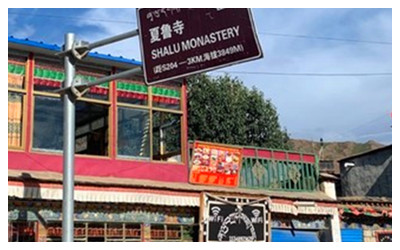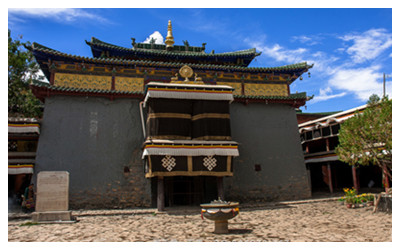Skype: neodalle-travel
Tel: +86 135 7447 2266
E-mail: sales@visitaroundchina.com
 Shalu Monastery, also Schalu Kloster, located 20 kilometers southeast of Shigatse City, is a perfect combination of Han and Tibet architectural styles. It was built in 1087 by Jigzun Xerab Qoinnyai. In 1320, it was administered by Master Purdain Renqen Zhuba, a renowned religious scholar who compiled the Tenjur sutra, one of the classic woks of Tibetan Budhism. It is said that about 3,800 monks were drawn to his teaching. Therefore, Shalu Monastery became a holy site for many worshipers. In 1329, it was destroyed in an earthquake. It was rebuilt in 1333 under the patronage of one emperor of the Yuan Dynasty (1271-1368). Since many Chinese artisans were assigned to reconstruction work, it integrated both Han and Tibetan architectural styles.
Shalu Monastery, also Schalu Kloster, located 20 kilometers southeast of Shigatse City, is a perfect combination of Han and Tibet architectural styles. It was built in 1087 by Jigzun Xerab Qoinnyai. In 1320, it was administered by Master Purdain Renqen Zhuba, a renowned religious scholar who compiled the Tenjur sutra, one of the classic woks of Tibetan Budhism. It is said that about 3,800 monks were drawn to his teaching. Therefore, Shalu Monastery became a holy site for many worshipers. In 1329, it was destroyed in an earthquake. It was rebuilt in 1333 under the patronage of one emperor of the Yuan Dynasty (1271-1368). Since many Chinese artisans were assigned to reconstruction work, it integrated both Han and Tibetan architectural styles. Xalhulhakang is the main structure here, which is architecturally distinctive. The hall has an arch-like ceiling covered with glazed tiles. The steep eaves are like the wings of a flying bird. The structure is a complete replica of inland temples. Shalu Monastery consists of two floors. On the first floor lies a main hall for assembly, covering an area of 1,500 sq meters. The statues of Sakyamuni and his disciples are worshiped there. On either side of the hall stands a sutra depository, where two important classics of Tibetan Buddhism - Tanjur and Kanjur are exhibited. The layout of the second floor is a typical Chinese quadrangle. The four halls stand in a symmetrical order. The murals are exquisitely painted and vivid, demonstrating the features of the Yuan Dynasty's paintings. The portrait of Bodhisattva preserved here is quite different from those of other temples. The artistic style is a combination of Chinese inland and exotic culture.
Xalhulhakang is the main structure here, which is architecturally distinctive. The hall has an arch-like ceiling covered with glazed tiles. The steep eaves are like the wings of a flying bird. The structure is a complete replica of inland temples. Shalu Monastery consists of two floors. On the first floor lies a main hall for assembly, covering an area of 1,500 sq meters. The statues of Sakyamuni and his disciples are worshiped there. On either side of the hall stands a sutra depository, where two important classics of Tibetan Buddhism - Tanjur and Kanjur are exhibited. The layout of the second floor is a typical Chinese quadrangle. The four halls stand in a symmetrical order. The murals are exquisitely painted and vivid, demonstrating the features of the Yuan Dynasty's paintings. The portrait of Bodhisattva preserved here is quite different from those of other temples. The artistic style is a combination of Chinese inland and exotic culture.Travel Tips
Add: 20 kilometers southeast of Shigatse City,Tibet
Opening Hours:09:00-17:00
Entrance Fees: CNY40
 Ask Questions ?
Ask Questions ?